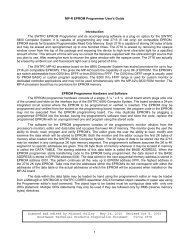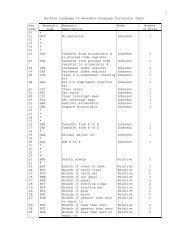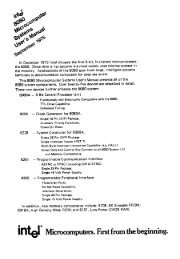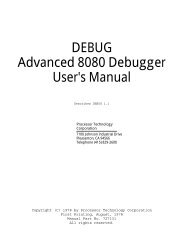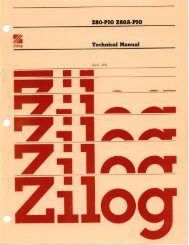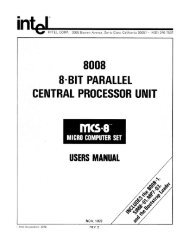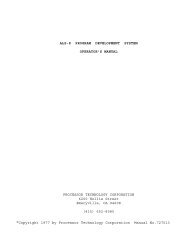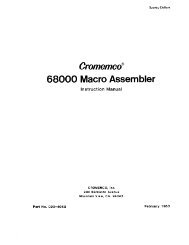The System Manual of SOL-20 - History of Computers
The System Manual of SOL-20 - History of Computers
The System Manual of SOL-20 - History of Computers
Create successful ePaper yourself
Turn your PDF publications into a flip-book with our unique Google optimized e-Paper software.
V. SUBROUTINES (cont.)<br />
B. <strong>System</strong> Entry Points<br />
<strong>The</strong>re are actually only two system entry points within the <strong>SOL</strong>OS<br />
jump table. Entry at these points does not require that any<br />
register be initialized. <strong>The</strong> first (at either label "START" or<br />
"INIT") is used to perform a complete power-on system reset. As<br />
a part <strong>of</strong> the system reset, the system RAM area data used by<br />
<strong>SOL</strong>OS will be cleared. <strong>The</strong> only reason for entering via "START"<br />
or "INIT" is that the power-on circuitry requires a one byte<br />
instruction to allow various circuits to stabilize. <strong>The</strong> other<br />
use <strong>of</strong> the byte labeled "START" is to determine if a user<br />
program is being executed under <strong>SOL</strong>OS or is CUTER controlled.<br />
When under <strong>SOL</strong>OS, this byte will be zero. When under CUTER,<br />
this byte will be non-zero.<br />
<strong>The</strong> other system entry point ("RETRN") is used to return to<br />
<strong>SOL</strong>OS command mode. This entry point does not perform a system<br />
reset.<br />
C. <strong>SOL</strong>OS Input Entry Points<br />
SINP<br />
entry point address C01F<br />
This entry point will set register "A" to the current system<br />
input pseudo port. <strong>The</strong> current system input pseudo port is<br />
changed by the "SET I=" command. After setting register "A",<br />
this command proceeds by executing an "AINP". (See below.)<br />
AINP<br />
entry point address C022<br />
This entry point is used to input one character or status from<br />
any pseudo port. Register "A" on entry indicates the desired<br />
input pseudo port from 0 to 3. Because this entry point is a<br />
combination status/get-character routine, it is the user's<br />
responsibility to interpret return flags properly. When a<br />
character is not available, the zero flag will be reset and the<br />
character will be placed into register "A". What this means is<br />
that, if the user wants to wait for a character to be entered,<br />
simply follow the CALL AINP (or SINP) with a "JZ" jump-if-zero<br />
instruction back to the call. A combined status/get-character<br />
routine is very important when allowing user written input<br />
routines.<br />
D. <strong>SOL</strong>OS Output Entry Points<br />
SOUT<br />
entry point address C019<br />
This entry point will set register "A" to the current system<br />
out-put pseudo port. <strong>The</strong> current system output pseudo port is<br />
changed by using the "SET O=" command. After setting register<br />
"A", this command proceeds by executing an "AOUT". (See next<br />
definition.)<br />
17



